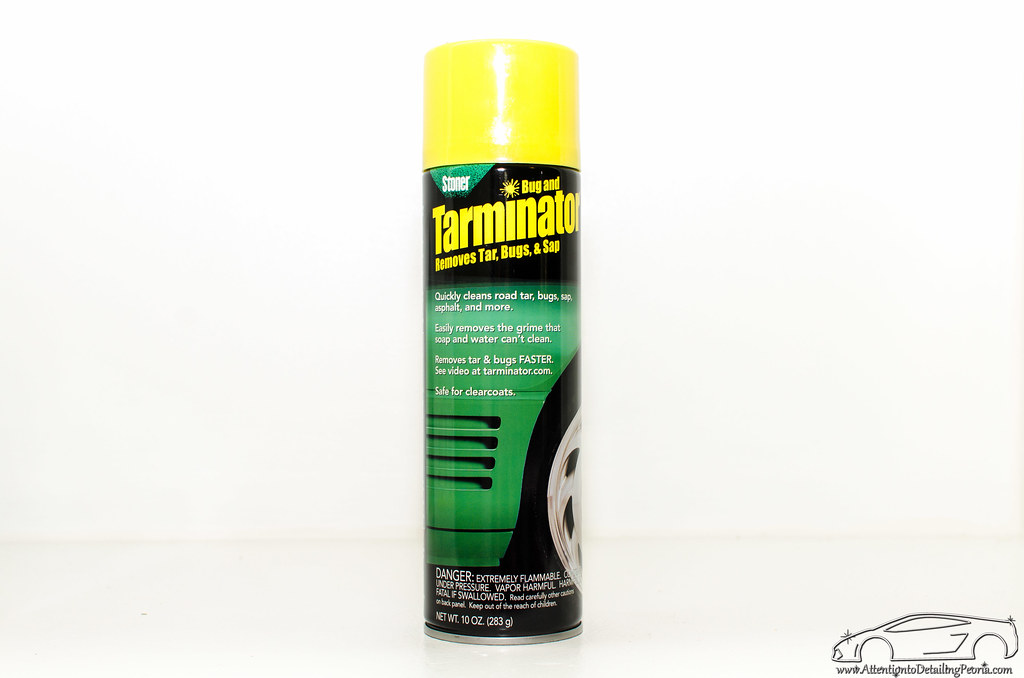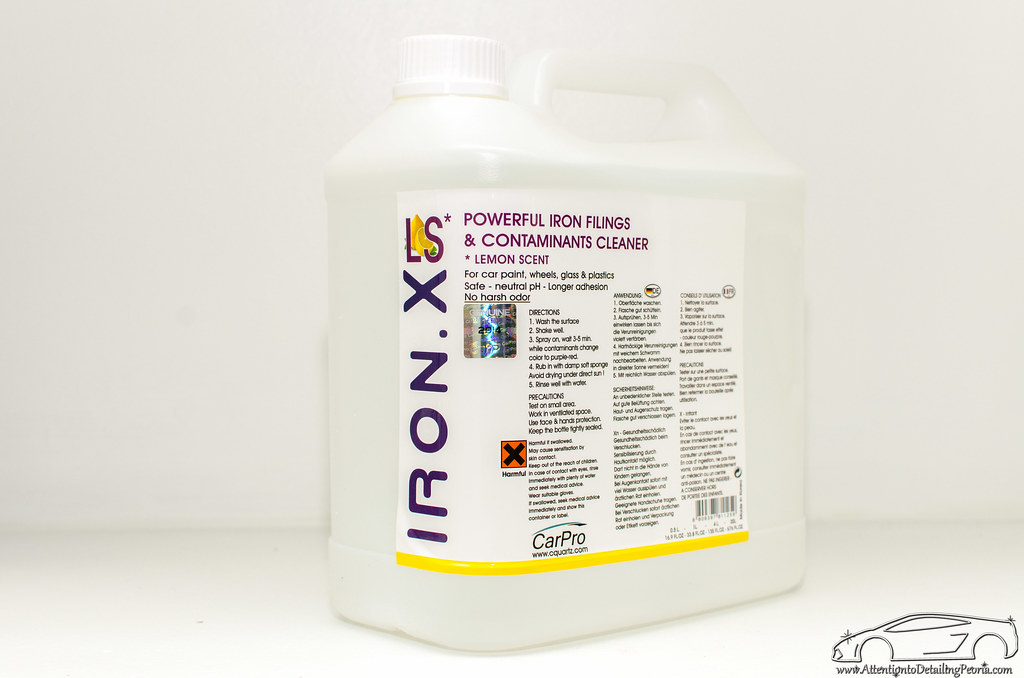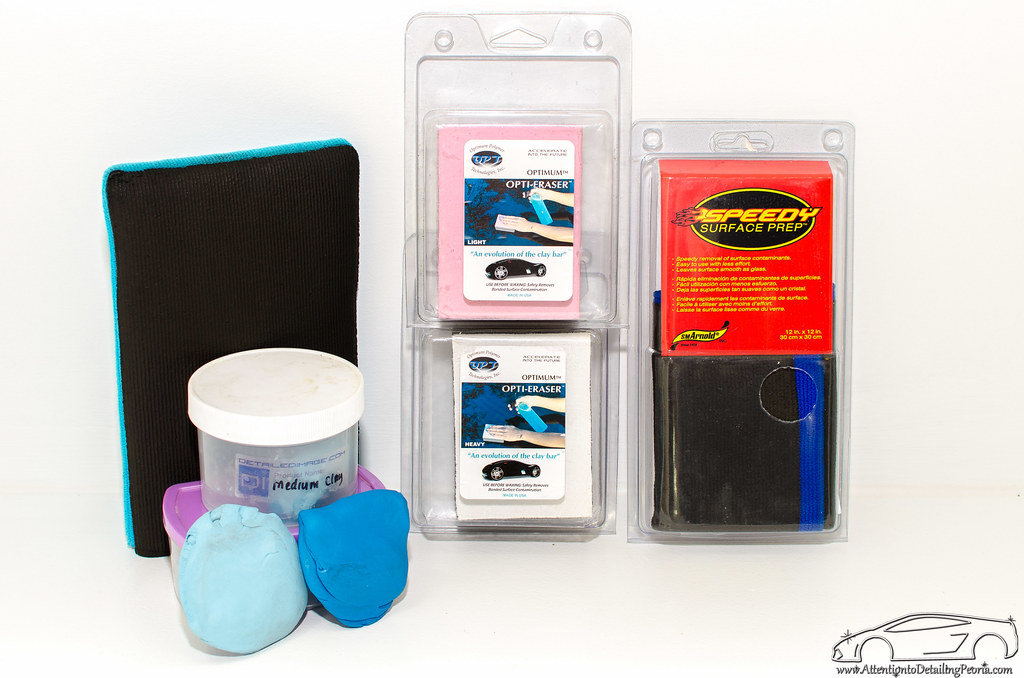Explaining the Decontamination Process (Part 1)
by Zach McGovernProperly cleaning and decontaminating your vehicle is an important part of the detailing process. With many new products available on the market, this is becoming an even more detailed process with more steps. When trying to implement new products into your routine, it can be difficult to understand when to use them. A very common question, for instance, is “Do I use Iron X before or after detailing clay?” In this article I will give a brief overview of some of the many decontamination products available on the market as well as a brief description of their intended use, and in Part 2 of this article I will discuss the general order of operations for each phase of the decontamination process.
Tar, Sap and Bug Removal

Photo: Stoner Tarminator Aerosol Can
Stoner Tarminator and CarPro Tar X are two of the most common products used for removing tar, bug, and sap buildup. These products are simply sprayed onto the effected area, and the solution will work to loosen the buildup from the surface making it much easier to wipe or rinse away. These chemicals make this type of task much quicker and easier than most manual types of decontamination (i.e. clay) for tar removal.
Iron Removal

Photo: 1 Gallon Iron X (Lemon Scent)
CarPro Iron X is perhaps the most common iron removal product on the market, and for good reason. Iron X works to quickly and easily remove bonded iron particles (also known as fallout or rail dust). Simply spray Iron X liberally onto the entire vehicle, and the chemical will react with any iron particles and dissolve them from the surface. The chemical changes from clear to purple as it reacts, so this is a very easy reaction to see on lighter colored vehicles. Beware of the smell, as it is far from pleasant, but the results make it tolerable.
General Bonded Contamination Removal

Photo (from left to right): Light Blue Medium Grade Clay, Blue Fine Grade Clay, Fine Grade Nanoskin Wash Mitt, Light & Heavy Opti-Erasers, Medium Grade Speedy Surface Prep Towel
Detailing clay is traditionally used to remove other bonded contamination from a vehicle, however with the increase in synthetic clay substitutes, there are now many more options that perform the same type of job. The NanoSkin Autoscrub line consists of a set of wash mitts (fine and medium grade), pads that attach to a DA machine (medium and fine grade), as well as a decontamination towel. Each of these Nanoskin products perform the same job as traditional detailing clay, however they often produce results much quicker than normal clay. Also, these synthetic clay bars can be used time and time again, where a traditional clay bar will get dirty and may need to be discarded after just a few uses. I will also add that these synthetic clay alternatives have been known to leave behind light marring that is especially noticeable on darker paint, which is why I only recommend using these products if you intend on polishing afterwards. Do not let this turn you away from these products as the time savings is dramatic and in my opinion, far outweighs the potential risk of marring, especially since the marring is typically easily removed with a light polish.
Part 2 of this series will explain what order to use these products in to achieve the best results in the least amount of time!
Buy Products From This Article
Purchase the products used in this article individually or in one convenient package here!








nice cant wait till the 2nd part is done as i have always been wondering if i been using my iron remover in the correct steps my normal process is to wash then spray iron remover and then nano scrub wash mitt
Excelent!!
Sorry folks, but when the precautions on the Iron Remover state use in a ventilated area, use rubber gloves and wash hands thoroughly after use, I don’t consider them safe. Those chemicals get washed into our sewers and do NOT get removed in normal water treatment plants; which means they get passed through the ecosystem. That means they end up in someone’s drinking water or food preparation, of bathing water downstream. They don’t just dissolve. We are getting contaminated aquifers all over this country. We’re in the northern states, at the head of the largest river in the country and we have entire suburbs on mandated home RO water filters and counties closing wells.
There has to be a better formulation. If not, time to find one. But please, stop turning a blind eye to this problem.
Hey Richard, thanks for the comment. To be fair, I would hope that most chemicals post those types of warnings. Personal safety is an often overlooked, but very important topic. I recommend gloves throughout the entire detailing process (yes, even when washing!). Regarding chemical runoff, there are containment measures that can be taken to capture residual chemicals during the cleaning process so they can be collected and discarded properly. Many states enforce a law that requires such a thing.
If I use the nano skin wash mitt, will it remove wax or sealant from the paint?
Hi Daniel, claying the vehicle has the potential to remove or degrade the layer of protection on your paint. As I mentioned in the article, I would recommend using traditional clay unless you are planning to polish the vehicle, then the artificial clay (ie nanoskin, speedy prep, etc) may be a better choice. The clay substitutes have a tendency to lightly mar the paint.
Thanks Zach, does that happen because the clay substitute loosens contaminants and push them around? Where as traditional clay would absorb them. I was hoping the clay substitute would be a quick way of decontaminating between polishing sessions but I guess I was wrong. Looks like I’ll be using my new Rupes 21 more often.
Daniel, yes, my assumption is that it is simply because the surface of the clay substitutes is simply not as soft/forgiving as traditional clay. Don’t get me wrong, I have used the clay mitts & sponges without producing marring, however there have been many cases where marring was left. Especially on softer, darker vehicles. You would have to experiment on your own vehicle to be certain. In any case, the marring is very light such that in my testing, even Menzerna SF4500 was able to completely remove it (testing done on a black Toyota). Hope that helps 🙂
Which products are best used to remove overspray